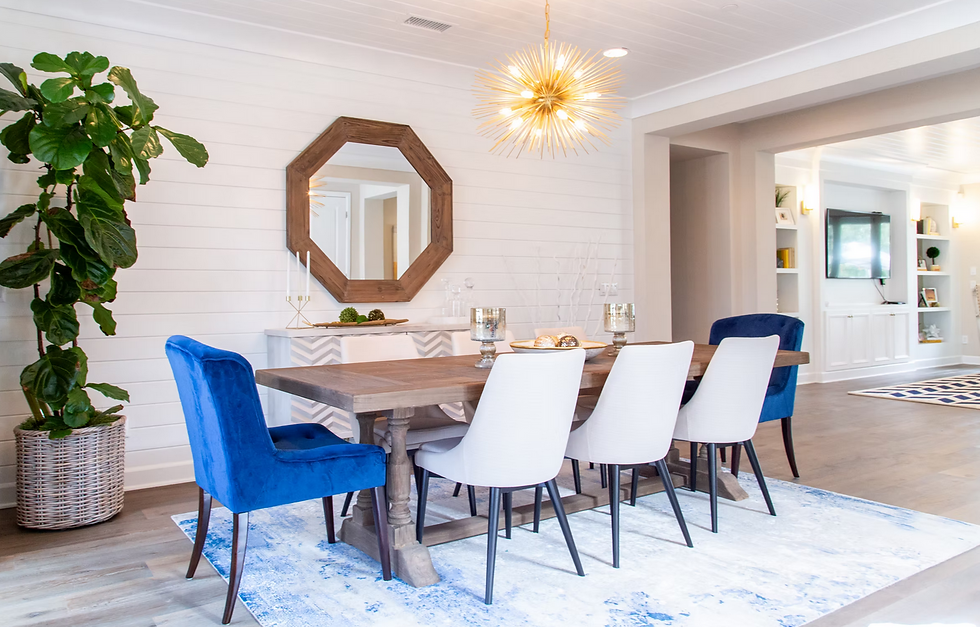Achieving Perfect Harmony: Tips for Selecting the Right Furniture Scale for a Room
- Vision Interiors
- May 26, 2023
- 3 min read

Choosing the right furniture scale is crucial for creating a well-balanced and visually appealing space. The size of your furniture can greatly impact the overall aesthetics and functionality of a room.
In this blog post, we will explore valuable tips for selecting the right furniture scale, ensuring that each piece complements the space harmoniously. With new ideas and advice, we aim to help you make informed decisions and achieve optimal balance in your home.
Measure and Assess the Room: Before selecting furniture, start by measuring and assessing the room. Take note of the dimensions, architectural features, and any existing furniture or focal points. This information will serve as a guide when determining the appropriate furniture scale. Consider the size of the room and aim for a balanced layout that allows for comfortable movement and ample space.
Consider Proportions: When selecting furniture, it's important to consider the proportions of the room. A general rule of thumb is to choose furniture that is proportionate to the size of the space. In smaller rooms, opt for sleek and compact furniture to prevent overcrowding. In larger rooms, consider larger statement pieces that can anchor the space without overwhelming it.
Create Visual Hierarchy: Creating a visual hierarchy through furniture scale is key to achieving a well-designed room. Identify the focal point of the space, such as a fireplace or a large window, and choose furniture that complements and enhances the prominence of that feature. For example, arrange seating around the fireplace to draw attention to it and create a cozy gathering area.
Mix and Match: Don't be afraid to mix and match furniture sizes to add visual interest and variety to the room. A combination of different scales can create a dynamic and layered look. For instance, pair a large sectional sofa with smaller accent chairs or a substantial dining table with petite side chairs. This interplay of scales adds depth and character to the space.
Consider Ceiling Height: The height of your room's ceiling is another factor to consider when selecting furniture scale. Taller ceilings can accommodate taller furniture pieces without overwhelming the space. In contrast, lower ceilings may benefit from lower-profile furniture to maintain a balanced and proportional look. Be mindful of how furniture height relates to the overall vertical space in the room.
Test Furniture Arrangements: To ensure the chosen furniture scale works well in the room, take the time to test different furniture arrangements. This can be done by sketching out the room layout or using online room planning tools. Experiment with various furniture configurations to find the arrangement that optimizes space, flow, and visual appeal. Don't hesitate to try different combinations until you achieve the desired result.
Consider Multifunctional Pieces: In rooms where space is limited, consider incorporating multifunctional furniture. These versatile pieces can serve dual purposes, such as a sofa bed or an ottoman with hidden storage. By selecting furniture that offers additional functionality, you can maximize space efficiency without compromising on comfort or style.
Conclusion
Selecting the right furniture scale is essential for creating a harmonious and well-proportioned room. By carefully measuring and assessing the space, considering proportions, creating visual hierarchy, mixing and matching, and taking ceiling height into account, you can make informed decisions that enhance the overall aesthetics and functionality of your home.
Remember to test furniture arrangements and consider multifunctional pieces to optimize space utilization. With these tips, you'll be on your way to creating a balanced and visually pleasing interior that reflects your personal style and enhances your everyday living experience.




Comments